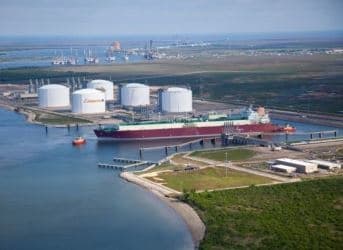Natural gas prices in the U.S. for quite a few years now have hovered between the $2 and $4 per million btu (MMBtu) range, while they have reached as high as $19/MMBtu in Japan. The oil and gas industry have pushed the federal government to accelerate its permitting of LNG export terminals in order to take advantage of what is seemingly an easy arbitrage opportunity. They also argue it will be good for the American economy, energy security, and national security. Earlier this month DOE approved its sixth permit allowing LNG exports to non-FTA countries.
Yet the opportunity to take advantage of that price differential between U.S. and Asian LNG spot prices may actually be quite smaller than many believe. A new study from Kenneth Medlock of the Baker Institute for Public Policy – who has some of the best research around on the economics of U.S. LNG exports – lends weight to that notion. The logic is pretty straightforward. The price differential between the U.S. and Asia is a temporary phenomenon brought on by the shale gas revolution in the U.S. and the “demand shock” of Fukushima – a rapid increase in LNG demand rapidly sent Asian LNG prices higher. And there are quite a few reasons why that will not last over the long-term (I also wrote about this in a report for the American Security Project last year).
Related Article: Small Companies Poised to Ride Canadian Natural Gas Wave
Asian LNG prices are unsustainably high. Increased LNG trade – not just from the U.S., but also Australia, Mozambique, and the Middle East – will provide greater supplies to the market, bringing Asian prices down. Moreover, the greater liquidity supplied to the market will erode the practice of oil-linked contracts, a common but soon to be outdated practice in Asia, further bringing down prices there.
Another reason the window may be short for U.S. LNG suppliers is that U.S. natural gas prices are unsustainably low. Indeed we have seen Henry Hub prices reach $6/MMBtu this month as cold weather set in. Prices in recent years may have been too low for drillers to make much money over the long haul. And opening up to trade will further increase domestic natural gas prices – a basic tenet of international trade says that domestic prices will converge towards the world price when you open up.
So you have greater supplies pushing Asian LNG prices down, and greater demand for U.S. LNG (from opening up to trade), which pushes up U.S. prices. That means that the $4/MMBtu U.S. price and the $19/MMBtu Asia price start converging towards each other. If Japan brings some or all of its remaining nuclear reactors back online, the downward trajectory for Asian LNG prices will accelerate.
Factoring in the cost of liquefaction, shipping, regasification, and distribution, and the window starts to close faster than some might think. Indeed, over the long-run, Medlock says it is likely that the difference between prices in U.S. and Asia will reach an equilibrium defined by the cost of transportation.
Related Article: DOE Approves Sixth LNG Export Terminal
That means that U.S. exporters won’t be making hand over fist the way it may seem at this point. As the window closes, some LNG export terminals may no longer be profitable. Right now there is a flurry of construction around the world focusing on taking advantage of the spread between Asian LNG prices and prices elsewhere. Medlock said in a call with reporters that because the spread is temporary, we are seeing “a classic overbuild on the part of the industry.”
However, he still notes that the effects of U.S. exports will be profound. While it won’t lead to a single world price for natural gas the way oil is priced, it will directly connect the U.S. natural gas market with the rest of the world. This will provide greater liquidity and reduce market volatility – i.e. should another supply or demand shock happen that rocks LNG markets the way Fukushima did, U.S. producers could expand exports pretty quickly to meet demand.
By Nicholas Cunningham of Oilprice.com

















